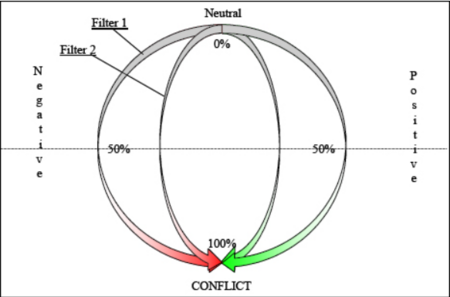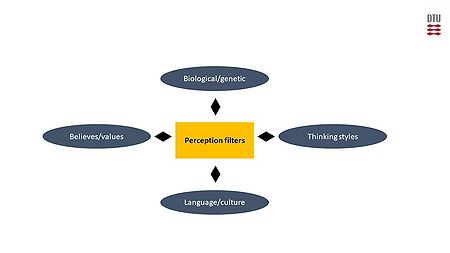Perception filters
Perception is the process in which a person interprets organizes and maintains informations from their environment. Perception filtering is in this process the subconscious selection on a subset out of a large number of present stimuli at any time [1]. This focus is individual and determined by biological, cultural and language prerequisites as well as values and thinking styles [2]. The process is necessary since the cognitive and physical capacity of individuals to process and respond to a large number of informations is limited [1]. Because of this filtering, persons exposed to the same set of informations can end up with a different perception and draw other conclusions. This can also lead to different attributions made by managers and workers explaining workplace behaviour and misunderstandings in project management [3]. Acknowledging the exsistance of perceptional filters and actively using them can be an important communication skill for mangers adressing messages and achieve the intented behaviour.
Contents |
Perception
Referenece to HALO effect possible ?
The goal of organizational communication is to influence the receptors perception and to adapt, confirm or change behaviour according to the senders intention.
The influence of perception on decision making is determined by two perspectives. The heuristics and biases containing emotions as a primary driver in a fast, automatic process and the cognitive process which is slow and logical.
To achieve this the communication needs to be adapted to the person and also to the organizational culture. [4]
Types of filters [2]
People are learning and developing references and frameworks in every moment, building up their own reality. These is influenced by predispositions, emotions, values, experiences and culture. In a business surrounding a uniform environment for perception is created. But all of these factors can act as filters influencing perceptions of messages and therefore the behaviour in each situations so they have to be recognized as well in business communication. Personal filters working like physical filters. Where small holes in plates allowing light with specific wavelength to pass so personal filters only allow certain parts of a message to pass to the receptor. In this process the receptor will compare the message with existing personal context in a specific area . If there is no match the message is compared to the other personal areas. When there is a match the message is translated within the receptors framework whereby parts of the message sometimes being omitted. This is a subconscious process which is driven by multiple perception filters.
- Biological/ Genetic
- Language/ Culture
- Believes/ Values
- Thinking styles
- Feelings/ Emotions
Family and environmental circumstances are also influencing business behaviour and the reception of messages. A bad week can make a person more responsive to confrontation and critical healthcare situations of a belonging can influence the attitude towards the importance of business decisions.
Relative Interpretation
It is known that the acknowledgement of a message is a personal interpretation of the message. A simple example is the relative interpretation of 3 letter abbreviations. For a person out of the communication industry ATM is more likely a communication method and for a banking person a bank automate whereby ATM can also simply mean at the moment. The differences in perceptions become bigger the more paraphrasing are use and the more feelings are involved.
Translation by filters
Filters can lead to an individual translation of a message. For example, the designation; you do it like a sales manager depends on the recipient's attitude towards the sales team and their previous experience. This message can be translated positive or negative and is related to the values created by the experiences. (Cultural example) But also cultural attitude towards hierarchical behaviour can influence the receipting of a managers message.
Blocking by filters
When a long message is delivered, filters can cause parts of the message to be blocked. If a message includes emotional and business related parts, the several parts are referred to the personal framework and can be disregarded as being not relevant.
Filters model
The filters model is the theory of the outcome of a combination of filters forming humans behaviour. According to the theory, it is not possible to select certain filters so that the recorded message is always influenced to a different extent by all the filters. They can be simplified sorted into positive and negative filters and the stronger this filters are the higher is the conflict potential. The puplication of a new IT-System from the company x for example can adress a positive filter related to the natural enthusiasm for changes with the negative filter in relation to bad experiences with the company. Additionally the model assumes that also all other filters like the personal background can not be ignored. The final reception of the message and the following actions that an individual takes are then depent on the weightning of the different filters. [2].

Project Manager behaviour
Acknowledging that their own perceptions are also influenced by filters is an important skill set for managers to make reasoned decisions. The decision-making in project management is thereby characterized by dynamic complexity. This is determined by the underlying of the problem itself and the "behavioral complexity" of group effects. [5].It is necessary for a project manager to manage the interactions between stakeholders effectively to ensure successful cooperation towards project outcomes and realization of benefits. The three main pillars of communication management are Planning communication, distributing communication and monitoring the impact of communication to increase the understanding among various stakeholders, providing accurate unbiased Information and minimize risk [6]. To find a common ground to communicate on can help to decrease the influences of the filters. Finding a field of shared experiences with multiple disciplines involved insures the knowledge of the filter in that area and is the basis for a more similar perception. The need for planning communication to match with the stakeholders needs and expectations includes effective measures and feedback mechanisms. Beside the planning and distribution of information, monitoring the impact of the communications is a responsibility of the project manager. Taking the existence of perceptual filters during this processes into account increases the understanding and resolve communication issues to minimize the risk [6].
Mind dancing
With manging the perception filters actively a project manager is able to influence the stakeholders expectations. This "mind dancing" approach creates the opportunity to have satisfied customers although the project scope is not completely fulfilled. As a project is not only determined by the results but more by the customers satisfaction the success can be increased with this approach. The first step is recognizing the existing of perception and filters in projects and teams. With this acknowledgement and ability to use this filters, strong project teams and stakeholder connections can be formed. Negative filters can be compensated with increasing positives for example by finding a personal connection. The most common example is to find a shared interest. Having something in common, is a starting point of building trust and therefore is lowering negative filters. Exploring the others interests besides the project and work lowering the walls and opens the filters one after the other. With this increased knowledge it is possible to understand the others personal project interests better and gain a better foundation to make decisions on [2].
Bibliography
- Belling, B. & Mangalaars, F. A. H. (2004). How filters and perceptions influence your thinking, behavioral and success in project management: "mind dancing" as a way to success and leadership
This paper published by the project management institute is focussing on how perception filters influence succes in project management. There are weaknesses in describing the excact phenomenon and gaps the difference between filters. The focus is primarily on the implications this psychological phenomenon has for project management. Multiple examples can be found additionally that are not are underexamined here.
Citation
- ↑ 1.0 1.1 https://dictionary.apa.org/perceptual-filtering
- ↑ 2.0 2.1 2.2 2.3 2.4 Belling, B. & Mangalaars, F. A. H. (2004). How filters and perceptions influence your thinking, behavioral and success in project management: "mind dancing" as a way to success and leadership. Paper presented at PMI® Global Congress 2004—EMEA, Prague, Czech Republic. Newtown Square, PA: Project Management Institute
- ↑ Williams, C. (2014). MGMT7. Cengage Learning
- ↑ H.M.F. Marynissen (2011) The Relationship between Organisational Communication and Perception, Acta Chirurgica Belgica, 111:4, 193-199
- ↑ Senge, P., Kleiner, A., Roberts, C., Ross, R., Roth, G., Smith, B., & Guman, E. C. (1999). The dance of change: The challenges to sustaining momentum in learning organizations
- ↑ 6.0 6.1 ISO 21502:2020 Project, programme and portfolio management — Guidance on project management; Chapter 7.1.3
